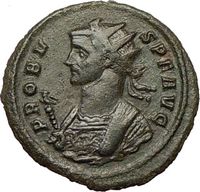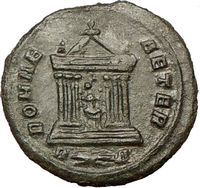Probus - Roman Emperor 276-282
A.D. Biography and Certified Authentic Ancient Coins Available to Invest
Into
Buy authentic ancient coins of Emperor Probus who
ruled 276-282 A.D. A fun way to learn about ancient history, by reading
the biography and seeing actual coins of ancient Rome. Get incredible
value, with the beautiful, custom-made, full-color,
professionally researched certificate of authenticity, a $50-$100 value
all in itself, absolutely free, no matter what coin
you buy. A fun way to learn about and preserve history for future
generations. Ancient coins make a great gift, investment
and collection all in one. Find out for your


Example of Authentic Ancient
Coin of:
Probus - Roman Emperor: 276-282 A.D.
Bronze Antoninianus Rome mint: 281 A.D.
Reference: RIC 187h, C 528
IMPPROBVSPFAVG - Radiate bust left, wearing imperial mantle, holding
scepter with eagle atop.
ROMAEAETER Exe: R(thunderbolt)B - Temple with six columns; Roma seated
within.
In
traditional Roman religion, Roma
was a female
deity who personified the city of
Rome and more broadly, the Roman state.
Her image appears on the base of the
column of Antoninus Pius. Roma,
formerly queen of almost the whole earth. Horace (L. iv. od. 3) calls
her the prince of cities; and according to Martial (L. xii. epig. 8) she
is terrarum dea gentiumque.
Marcus Aurelius Probus (c. August
19, 232–September/October, 282) was a
Roman Emperor (276–282).
 A
native of
Sirmium (now
Sremska Mitrovica,
Serbia), in
Pannonia, at an early age he entered
the army, where he distinguished himself under the Emperors
Valerian,
Aurelian and
Tacitus. He was appointed governor of
the East by Tacitus, at whose death he was immediately proclaimed his
successor by the soldiers (276). A
native of
Sirmium (now
Sremska Mitrovica,
Serbia), in
Pannonia, at an early age he entered
the army, where he distinguished himself under the Emperors
Valerian,
Aurelian and
Tacitus. He was appointed governor of
the East by Tacitus, at whose death he was immediately proclaimed his
successor by the soldiers (276).
Florianus, who had claimed to succeed
his half-brother Tacitus, was put to death by his own troops after an
indecisive campaign. Probus moved to the West, defeated the Goths
acquiring the title of Gothicus (280), and saw his position
ratified by the
Senate.
The reign of Probus was mainly spent in successful
wars by which he re-established the security of all the frontiers. The
most important of these operations were directed to clearing
Gaul of German invaders (Franks,
Longiones,
Alamanni and
Burgundians), allowing Probus to adopt
the titles of Gothicus Maximus and Germanicus Maximus. One
of his principles was never to allow the soldiers to be idle, and to
employ them in time of peace on useful works, such as the planting of
vineyards in Gaul, Pannonia and other districts, in order to restart the
economy in these devastated lands.
In 279–280, Probus was, according to
Zosimus, in
Raetia,
Illyricum and
Lycia, where he fought the
Vandals. In the same years, Probus'
generals defeated the
Blemmyes in
Egypt; Probus ordered the
reconstruction of bridges and canals along the Nile, where the
production of grain for the Empire was centered.
In 280–281, Probus had also put down three usurpers,
Julius Saturninus,
Proculus and
Bonosus. The extent of these revolts is
not clear, but there are clues that they were not just local problems.
In 281, the emperor was in Rome, where he celebrated his
triumph.
Probus was eager to start his eastern campaign,
delayed by the revolts in the west. He left Rome in 282, moving first
towards Sirmium, his birth city, when the news that
Marcus Aurelius Carus, commander of the
Praetorian Guard, had been proclaimed
emperor reached him. Probus sent some troops against the new usurper,
but when those troops changed sides and supported Carus, Probus's
soldiers then assassinated him (September/October 282).
|